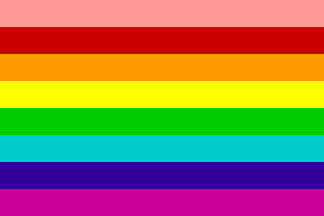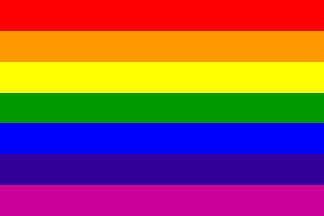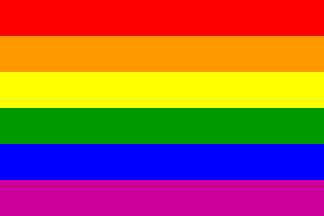
This page is part of © FOTW Flags Of The World website
History of the Gay Pride / Rainbow Flag
Sexural Orientation Flags
Last modified: 2025-01-11 by randy young
Keywords: rainbow flag | gay pride | baker (gilbert) | steve (tyson) | international congress of flag makers | flag of the race | stripes: 8 | stripes: 7 | stripes: 6 | stripes: 5 |
Links: FOTW homepage |
search |
disclaimer and copyright |
write us |
mirrors
See also:
Long-Lost Fragment of First Rainbow Pride Flag Resurfaces After Four Decades
The brilliantly colored banner—now on view in San Francisco—flew on "Gay Freedom Day" in 1978
By Nora McGreevy
June 16, 2021
A priceless piece of queer history has returned home to San Francisco, reports Ezra David Romero for KQED. Earlier this month, the GLBT Historical Society Museum unveiled a glass case containing a rare artifact: a segment of the original rainbow gay pride flag, its colors as vibrant as ever.
Now an internationally recognized symbol of LGBTQ pride and civil rights, the rainbow flag design was conceived by a group of activists in San Francisco in 1978. Per a statement, its creators included queer artists Gilbert Baker, Lynn Segerblom and James McNamara, as well as more than 30 volunteers.
The rare fragment—presumed lost for more than four decades—resurfaced last year, writes Peter-Astrid Kane for the Guardian. It will be featured as the centerpiece of "Performance, Protest and Politics: The Art of Gilbert Baker," an ongoing exhibition about the activist's life and work. (Viewers can peruse an online version of the show here.)
Baker, Segerblom, McNamara and other activists first flew two versions of their brilliantly colored flag at the United Nations Plaza on June 25, 1978, in celebration of "Gay Freedom Day." Each measuring 30- by 60-feet, the designs were hand-stitched and dyed with eight colored stripes: pink to symbolize sex, red for life, orange for healing, yellow for the sun, green for nature, turquoise for art and magic, blue for serenity, and purple for the spirit, according to the online exhibition.
One of the flags also featured a riff on the United States' national flag, with blue-and-white tie-dyed stars in its upper corner. (Later iterations of the flag dropped the hot pink and turquoise stripes because they were costly to produce.)
Lynn Segerblom (Faerie Argyle Rainbow) pictured with one of the original rainbow flags she helped design in 1978 (https://commons.wikimedia.org/wiki/File:Lynn-segeblom-with-flag-1978.jpg)
In his memoir, Baker wrote that the rainbow design was "natural and necessary," adding that the motif "came from earliest recorded history as a symbol of hope."
The artist proposed a rainbow as a "modern alternative" to the pink triangle—a symbol used by the Nazis to mark and persecute gay people, and one which queer communities have since reclaimed as a symbol of pride.
"[The rainbow flag] doesn't say the word 'Gay,' and it doesn't say 'the United States' on the American flag, but everyone knows visually what they mean," Baker said in a 2015 conversation with curator Michelle Millar Fisher. "...And flags are about proclaiming power, so it's very appropriate."
Despite their outsized global impact, the two original flags were thought to be lost for more than four decades. One flag was stolen from a community center and never recovered. But Baker managed to quietly rescue a 10- by 28-foot segment of the second flag, which had been placed in storage after sustaining water damage, as GLBT Historical Society executive director Terry Bewsick tells the Guardian. Baker took the item with him when he moved to New York City in 1994.
After Baker's death in 2017, the flag and his other belongings were shipped to his sister, who later passed the fragment along to Charley Beal, president of the Gilbert Baker Foundation. Beal did not realize he was in possession of the original 1978 banner until early 2020, when a vexillologist (or flag expert) examined the item firsthand and confirmed its provenance, per the statement.
The flag is now part of the GLBT Historical Society's permanent collection. Speaking with KQED, Beswick says he traveled to New York to transport the rare flag-packed in a lavender suitcase-back to San Francisco himself. He adds that the iconic rainbow design has succeeded in part because it conveys a bright, hopeful message.
"People hang it in small towns and in countries where they still experience a lot of oppression," Beswick notes, "but it also has become a political statement to say that we exist, we have the right to love who we want to love and to participate as full members of society."
submitted by William Garrison, 17 June 2021
Source: https://www.smithsonianmag.com/smart-news/original-rainbow-pride-flag-returns-san-francisco-after-43-years-180978000/?utm_source=smithsoniandaily&utm_medium=email&utm_campaign=20210616-daily-responsive&spMailingID=45156678&spUserID=ODcyNjc0Njc3NDYzS0&spJobID=2024365233&spReportId=MjAyNDM2NTIzMwS2

image by António Martins, 20 April 1999
The first Rainbow Flag was designed in 1978 by Gilbert Baker, a San Francisco artist, who created the flag in response to a local activist's call for the need of a community symbol. (This was before the pink triangle was popularly used as a symbol of pride.) Using the five-striped "Flag of the Race" as his inspiration, Baker designed a flag with eight stripes. Baker dyed and sewed the material for the first flag himself — in the true spirit of Betsy Ross.
Christopher Pinette, 12 June 1996
The design may have been influenced by flags with multicolored stripes used by various left-wing causes and organizations in the San Francisco area in the 1960s. The Rainbow Flag originally had eight stripes (from top to bottom):
- hot pink for sex,
- red for life,
- orange for healing,
- yellow for sun,
- green for serenity with nature,
- turquoise for art,
- indigo for harmony, and
- violet for spirit.
Handmade versions of this flag were flown in the 1978 Gay Freedom Day Parade.
Steve Kramer, 24 April 1998
Use of the rainbow flag by the gay community began in 1978 when it first appeared in the San Francisco Gay and Lesbian Freedom Day Parade. Borrowing symbolism from the hippie movement and black civil rights groups, San Francisco artist Gilbert Baker designed the rainbow flag in response to a need for a symbol that could be used year after year. Baker and thirty volunteers hand-stitched and hand-dyed two huge prototype flags for the parade. The flags had eight stripes, each color representing a component of the community.
M. Schmöger, 26 August 2001
quoting from this page
The flag was used in New York City on 12 November 2008, during the demonstration in support of the marriage equality, at the San Francisco Pride on 28 June 2009, at the National Equality March in Washington, DC, on 11 October 2009, and at San Diego, California, in February 2012 (exact date not specified).
One of the latest occasions when it was used was in Washington, DC, on 28 April 2015, at the rally during the session of the Supreme Court of the USA at which the arguments were heard concerning whether same-sex marriage is a Constitutional right (ruled that it is, on 26 June 2015). The photos from the rally can be found here and here.
The flag is being introduced outside the USA as well. It was used in Sweden, at Stockholm Pride 2008 and Stockholm Pride 2009, and one of the most recent examples of its use was in Riga, Latvia, on 20 June 2015, with the photos available here and here.
Tomislav Todorović, 27 June 2015
images by Tomislav Todorović, 19 January 2020
Even after the six-striped version of the flag had prevailed, some eight-striped flags were still used in San Francisco for several years, but their design differed from the one introduced by Gilbert Baker. The colors which appeared on them were: red, orange, yellow-orange, yellow, green, light blue, dark blue and purple. The flag makers, while having remembered their original number, clearly did not remember the actual colors very well, believing that they were supposed to match the real rainbow as close as possible. The earliest currently known photo was taken on 29 June 1980, during the Gay Freedom Day festival [1, 2] and shows two flags hoisted with the opposing color orders, one with red and the other with purple at the top. The same hoisting arrangement of eight-striped flags was seen again on 29 June 1986, at the San Francisco Pride festival (officially named International Lesbian & Gay Freedom Day Parade) [1, 3], but there are also the examples of a single flag in use [4, 5].
The actual color shades vary between the photos, some of which should be attributed to the picture making conditions, but the dye used for particular flag copies might have varied as well. The colors on the 1980 photo look very dark [2]. purple and dark blue being virtually indistinguishable, orange and red just a bit easier to tell apart, yellow-orange actually looking like light to medium orange and light blue looking like medium blue; it is the fact that each of rainbow flags is accompanied with a row of plain flags, each in one of its colors, that reveals the exact design. On the 1986 photos [3, 4, 5], the colors are much lighter. especially yellow-orange, which looks more like dark yellow, and dark blue, which sometimes looks more like a rather light shade of violet-blue. As the shades are much more distinctive on these photos, they served as the model for the images resented here.
There are currently no known photos of these flags made after 1986, so it is not known yet if that was their last appearance, although that is very much possible.
Tomislav Todorović, 19 January 2020
Sources:
[1] San Francisco Pride at Wikipedia - History (including list of dates and official names of each year's festivals): https://en.wikipedia.org/wiki/San_Francisco_Pride#History
[2] Queer History For the People website - a necrologue to Gilbert Baker (saved at the Internet Archive on 2018-02-23): http://web.archive.org/web/20180223200047/https://medium.com/queer-history-for-the-people/dear-gilbert-f475a6efb9ba
[3] Flickr - Photo from San Francisco Pride 1986: https://www.flickr.com/photos/alan-light/1929067635/
[4] Flickr - Photo from San Francisco Pride 1986: https://www.flickr.com/photos/alan-light/1929924394/
[5] Flickr - Photo from San Francisco Pride 1986: https://www.flickr.com/photos/alan-light/1929927762/
images by Tomislav Todorović, 19 January 2020
In 1980, each of eight-striped rainbow flags was accompanied with a row of plain flags, each in one of used colors [2]. These flags were also arranged in opposing orders - that is, arranged in the order matching the one seen in the accompanied rainbow flag, the closest flag being the one in the topmost rainbow color. This photo is currently the only known evidence of their use, so it is still unknown whether they were ever used afterwards.
As the colors are not easy to distinguish in the 1980 photo [2], the images of these flags were reconstructed using the 1986 photos of eight-striped flags as the model [3, 4, 5].
Tomislav Todorović, 19 January 2020
Sources:
[1] San Francisco Pride at Wikipedia - History (including list of dates and official names of each year's festivals): https://en.wikipedia.org/wiki/San_Francisco_Pride#History
[2] Queer History For the People website - a necrologue to Gilbert Baker (saved at the Internet Archive on 2018-02-23): http://web.archive.org/web/20180223200047/https://medium.com/queer-history-for-the-people/dear-gilbert-f475a6efb9ba
[3] Flickr - Photo from San Francisco Pride 1986: https://www.flickr.com/photos/alan-light/1929067635/
[4] Flickr - Photo from San Francisco Pride 1986: https://www.flickr.com/photos/alan-light/1929924394/
[5] Flickr - Photo from San Francisco Pride 1986: https://www.flickr.com/photos/alan-light/1929927762/

image by António Martins, 20 April 1999
After the November 1978 assassination of San Francisco Mayor George Moscone and openly gay Supervisor Harvey Milk and the subsequent lenient sentence given to their killer, former Supervisor Dan White, the Rainbow Flag began to be used in San Francisco as a general symbol of the gay community. San Francisco-based Paramount Flag Co. began selling seven-striped (top to bottom: red, orange, yellow, green, blue, indigo, and violet) flags from its Polk Street retail store, which was located in a large gay neighborhood. These flags were surplus stock which had originally been made for the International Order of Rainbow for Girls, a Masonic organization for young women. When Baker approached Paramount to make flags for the 1979 Gay Freedom Day Parade, Paramount informed Baker that fabric for hot pink was not available for mass production, and Baker dropped the hot pink stripe.
Steve Kramer, 24 April 1998
The reality was that the gay community at this time (1978-1979) used almost any flag with a rainbow of stripes, including the Cooperativist flags, Buddhist flags, Sufi flags, Tibetan flags; in short, anything — even vertically striped flags.
Jim Ferrigan, 10 February 2003
During the early days of the use of the rainbow as a symbol of gay pride (as opposed to gay liberation, which used the pink triangle on various colored fields) customers bought almost anything striped. At the Paramount Flag Co, the need for striped flags became acute and until the design was standardized we sold a wide variety of flags.
Jim Ferrigan, 10 February 2003

image by António Martins, 20 April 1999
Baker also asked Paramount to make vertical banners that would be split and displayed from the angular double bars of the old-style lamp posts on Market Street. Baker and Paramount's vice president Ken Hughes agreed to drop the hot pink and turquoise stripes and replace the indigo stripe with royal blue — resulting in three stripes on one side of the lamp post and three on the other.
Steve Kramer, 24 April 1998
Soon the six colors were incorporated into a six-striped version that became popularized and that, today, is recognized by the International Congress of Flag Makers.
Christopher Pinette, 12 June 1996
The article at sfWeekly.com says that "Old Glory Red was replaced with Canadian Red, and Emerald Green simply became Bright Green."
António Martins, 17 June 2000
"Gilbert Baker, Inventor of Rainbow Pride Flag, Dies at 65"
http://www.nbcnews.com/feature/nbc-out/gilbert-baker-inventor-rainbow-pride-flag-dies-65-n741546
April 1, 2017
by Reuters
Gilbert "Clive" Baker, a San Francisco-based activist and artist best known for creating the rainbow flag representing gay rights, has died at the age of 65, his longtime friend announced on social media on Friday.
"My dearest friend in the world is gone. Clive Baker gave the world the rainbow flag, he gave me forty years of love and friendship," Cleve Jones said on Twitter.
No details were immediately available on the cause of Baker's death or where he died. According to the biography posted on his official website, he had been living in New York City.
Jones also tweeted a photo of Baker with former President Barack Obama, inviting mourners to meet him under a rainbow flag in the Castro district of San Francisco on Friday evening to remember his friend.
Baker, who was born in Kansas in 1951, was stationed in San Francisco in the early 1970s while serving in the U.S. Army, at the start of the gay rights movement.
According to the website biography, Baker began making banners for gay rights and anti-war protests, often at the request of Harvey Milk, who would become the first openly gay man elected to public office in California when he won the 1977 race for a seat on the San Francisco Board of Supervisors.
Milk rode under the first rainbow flags made by Baker at the San Francisco Gay Freedom Day Parade in June 1978, just months before the politician was murdered by a former city supervisor, the biography says.
Ben Cahoon, 2 April 2017
Regarding the gay pride rainbow flag, there was a good article in the Flag Bulletin [tfb] some years ago that gave a long history of rainbow flags and their use as a symbol of hope for difficult causes. At the NAVA conference in Sacramento, Steve Tyson, a former employee of the former flag company, Paramount Flag Co., in San Francisco presented a lecture on the origins of this particular flag. Apparently, he had taken remnants, scraps of flag material and gone to the production department to make decorative flags to use up the scrap material. He showed several variations. The horizontal stripes (with white in the center) become popular. The company chose to produce it (without the white stripe) and from there it was adopted as a gay pride flag. I am not familiar with the actual procedure of the adoption by the gay community although I think Mr. Tyson did make some reference to that.
Herold Lee, 8 January 1998
There is no "International Congress of Flag Makers" that "recognizes" flags. This is a suppositious organization. It has never existed. We see it often in association with the Rainbow Flag in San Francisco. What this is a contraction of two names, the English version of FIAV, or the International Association of Vexillological Associations, and Flag Congress. The term Flag Congress was the meeting name of the joint meetings FIAV XII and NAVA XXI, held in San Francisco, CA, in the Summer of 1987. The largest such meeting ever held, hosting over 150 vexillologists from 16 nations. The "International Congress of Flag Makers" was inadvertently created by Gilbert Baker when he was interviewed by the representatives of the Gay press in San Francisco, during Flag Congress. During that interview Mr. Baker confused the organization FIAV and the event Flag Congress. The result was this supposed organization. By "recognition" he was in fact referring to the paper I presented at Flag Congress entitled "The Evolution and Adoption of the Rainbow Flag in San Francisco," in which the full details of the Rainbow Flag are chronicled. It was published as [fer89].
James Ferrigan, 25 March 1999
What's this "five-striped Flag of the Race," which supposedly inspired the gay rainbow flag? The only such flag I know, la bandera de la raza, shows three purple crosses and a sun — no stripes at all.
António Martins, 20 April 1999
![[Rainbow flag variant]](../images/q/qq-rb8a1.gif)
![[Rainbow flag variant]](../images/q/qq-rb8a2.gif)


![[Rainbow flag variant]](../images/q/qq-rb8a1.gif)
![[Rainbow flag variant]](../images/q/qq-rb8a2.gif)
![[Red flag]](../images/q/qq-8pfa_r.gif)
![[Orange flag]](../images/q/qq-8pfa_o.gif)
![[Gold flag]](../images/q/qq-8pfa_o-.gif)
![[Yellow flag]](../images/q/qq-8pfa_y.gif)
![[Green flag]](../images/q/qq-8pfa_v.gif)
![[Light blue flag]](../images/q/qq-8pfa_b-.gif)
![[Blue flag]](../images/q/qq-8pfa_b.gif)
![[Purple flag]](../images/q/qq-8pfa_p.gif)

